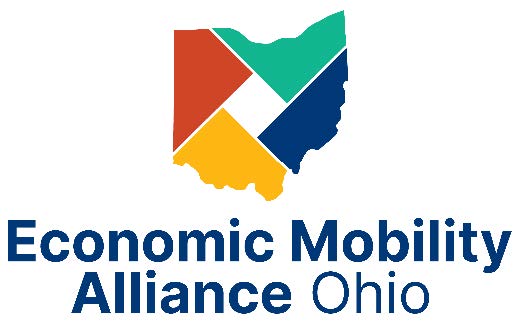Ohio Workers Can No Longer Wait For Comprehensive Solutions To Benefits Cliffs
Cincinnati, OH (August 14, 2024) – Now is the time for Ohio to address benefits cliffs according to the newly-formed Economic Mobility Alliance Ohio (EMAO) as workers earning less than 200 percent of the Federal Poverty Level (FPL) or $51,640 per year for a family of three – continue to face benefits cliffs when a small increase in income results in a decrease or loss in public assistance benefits. When this loss is greater than the increase in compensation, low-income working households face a net loss in their household budgets.
Benefits cliffs vary across public programs. In the Supplemental Nutrition Assistance Program (SNAP), food assistance is tapered, and participants receive lower benefit amounts as they earn more, creating a smaller cliff. In Medicaid, however, medical coverage ends suddenly and even earning $1 over the eligibility limit means an abrupt and total loss of the benefit. In Publicly Funded Child Care (PFCC), families are able to receive childcare assistance as their income grows to 300 percent FPL, but as co-payments begin at 100 percent FPL, families face sharply increasing cost-sharing requirements that reach 27 percent of a family’s income and create cliffs within the PFCC program.
Cliffs make the path out of poverty and toward financial stability nearly impossible to navigate or attain alone. Ohio United Way research shows that 1.9 million Ohio households, or 39 percent, fall under the Asset Limited, Income Constrained, Employed (ALICE) threshold, meaning they cannot afford the basic cost of living in their county and struggle to make ends meet.
EMAO is a newly formed coalition of state and local advocacy, research, workforce development, business, and health and human service organizations and funders committed to ending the system of disincentives to work known as benefits cliffs that trap Ohioans in poverty. As a collaborative, EMAO raises awareness and advocates for positive solutions that mitigate and ultimately eliminate benefit cliffs, reduce disincentives to work, and create a more seamless pathway to economic stability and security for all Ohioans.
EMAO is led by Holly Hankinson, Advocacy Director of the Women’s Fund of the Greater Cincinnati Foundation; Sarah Hudacek, Coalition Manager of Advocates for Ohio’s Future; Jason Kluk-Barany, External Affairs Associate and Emily Campbell, President and CEO of The Center for Community Solutions; Renée Timberlake, Director of the Built Environment Collaborative of the Cleveland-Cuyahoga County Workforce Development Board; David White, Director of Workforce and Policy of the Greater Sandusky Partnership; Rebecca Kusner, Director of the Ohio Workforce Coalition; and Maryam Kiefer, Director of Public Policy at United Way of Greater Cleveland.
By addressing benefits cliffs and facilitating a smoother pathway to economic stability, Ohio workers will no longer have to choose between retaining public assistance benefits or a raise, promotion, and career advancement opportunity. Employers will benefit from a more skilled and motivated workforce with higher job satisfaction, lower turnover, and reduced hiring and training costs. Encouraging upward mobility also reduces poverty, allowing Ohioans to more easily move on from public assistance, improving residents’ quality of life, and transforming Ohio’s public benefits system and the resources needed to fund it.
More attention has been focused on building bridges across these cliffs nationwide due to the work of many advocates throughout the state of Ohio and the nation. In recent years, Ohio has made promising progress through policies like the Benefit Bridge Pilot, increased eligibility and investment in public child care programs, and an improved benefits off-ramp for SNAP, among other initiatives.
However, benefits cliffs still impact Ohioans throughout the state, working in many different industries, across various public benefits programs, and in various ways based on each Ohioan’s family and financial situation.
“Ohioans can no longer wait for the policy changes and solutions necessary to reduce and eliminate benefits cliffs,” said EMAO Leadership. “The time to act is now as many Ohioans continue to live in crisis despite their best efforts and desire to achieve financial stability and economic mobility as members of our workforce. Effective policy can provide relief, and we look forward to working with policymakers, advocates, businesses, and workers across Ohio to make such relief a reality.”
“For over a decade, the Women’s Fund has researched and conducted advocacy to address benefits cliffs, a critical barrier to economic mobility that disproportionately impacts women. As part of EMAO, we are looking forward to raising awareness and driving statewide solutions to this important issue,” said Holly Hankinson, Advocacy Director, Women’s Fund of the Greater Cincinnati Foundation.
Benefits cliffs are solvable and preventable through cross-sector partnerships that lead to intentional, systemic policy change. EMAO will primarily focus its work on state policy change.
Watch the WLWT 5 Interview here.
Register here for EMAO’s first webinar, Benefits Cliffs 101, on Wednesday, August 28 at 1:00 p.m.
###
About Women’s Fund of Greater Cincinnati Foundation
The Women’s Fund’s mission is to advance gender and racial equity for women by addressing systemic barriers to upward mobility.
Media Contact
Michelle Hopkins
Communications Director
Women’s Fund of Greater Cincinnati Foundation
513-768-6161
michelle.hopkins@gcfdn.org
